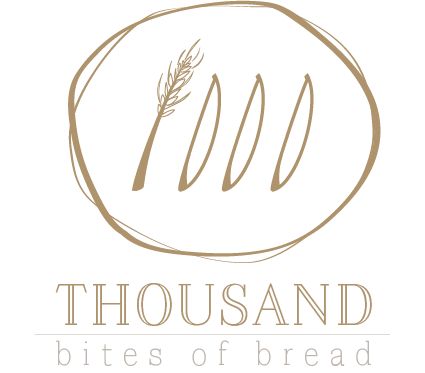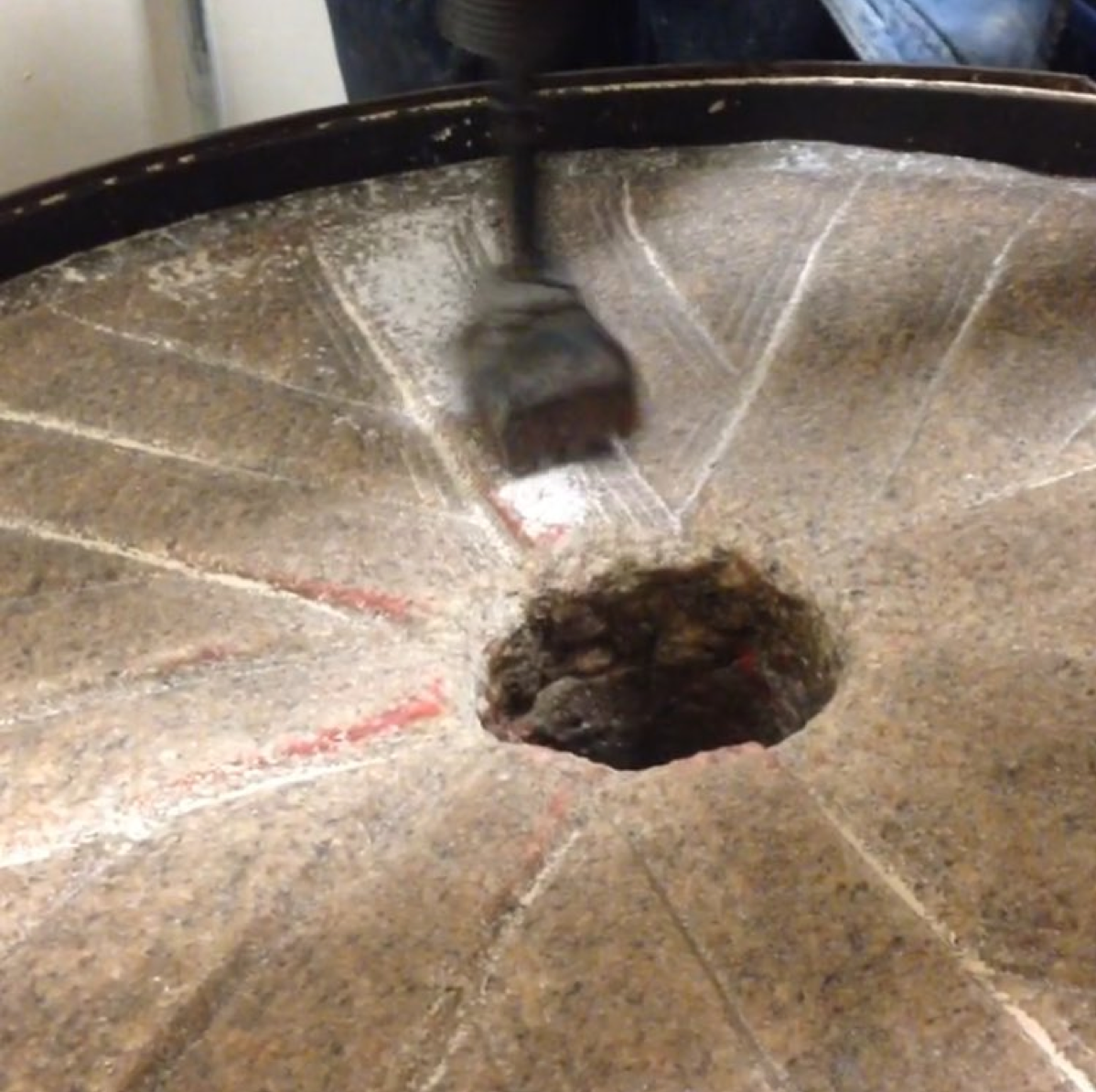The second time I met Clif Leir he was covered in dust and taking a break from grinding grooves into a thirty-inch round piece of pink grey granite. The granite was to become the bottom stone of a flour mill he was building for a friend. When assembled and operating, wheat would travel in the grooves—known as furrows—and get sheared into progressively smaller pieces by the top stone that rotated over the bottom stone. Building the mill was precise, hard work—the type of work that I sensed Clif loved to do. The first time I met Clif was at Fol Epi—his bakery on the western edge of Victoria, B.C. His craftwork was everywhere on display at Fol Epi; In his stone mill that was grinding wheat into flour; In his wood-fired oven that was turning dough into bread; In the precision-tuned systems that made optimal use of the tiny space. But most of all, his craftwork was evident in the bread—some of the best, most aromatic bread that I have ever tasted.
My visit to Fol Epi was part of my tour of people whom I refer to as stone punks—the collection of millers and bakers who live in a world in which white flour does not exist: their means of processing grain is the stone mill. To stone mill is to step back in time in this age of large industrial roller mills that convert grain into white flour by the trainload. Stone milling has become something of a phenomenon with a number of new mills or mill bakeries opening up in recent years. I was inspired to start out on my tour because I had heard that stone milling produced markedly better flour, which in the right hands could lead to bread and baked goods that were extraordinary. My visit to Fol Epi provided validation as did my visits to other bakeries. Yet my tour did more than provide validation. I learned that what’s at the heart of the stone mill is not the mill or the bread, but the capacity it has to bring people together.
Stone mills were nearly relegated to the dustbin of history with the ascendancy of roller mills. Roller mills were invented in Hungary in the mid-1800s as a clever way to avoid taxes that were being levied on each millstone in a flour mill. Outside of Hungary they became popular because they were capable of much higher volumes than stone mills. They also could do something stone mills could never do—remove all of the bran and all of the germ from the kernel of wheat to produce truly white flour made up almost entirely of the starchy compounds and proteins found in the endosperm. White flour is what people thought they wanted. White flour from the new industrial roller mills won competition after competition in milling and baking exhibitions at the same time that it was pushing stone milled flour out of the marketplace.
Stripped of fats, complex carbohydrates, and phytonutrients at the roller mill, white flour is a fundamentally different food than traditional stone milled flour. Sure, it can make cotton candy light loaves of bread, but white flour cannot sustain us. Almost immediately after its introduction, people started to experience nutritional deficiencies. In the 1940s, mills began to add iron and B vitamins back into white flour to compensate for what was removed. Today we’re learning that it wasn’t enough. Recent science suggests we need the complex carbohydrates and fats that are removed to make white flour. Industrial mills have responded by promoting their ‘whole grain’ flour—flour made by adding bran and germ back to white flour after it has been milled. While I see this as a good thing, I am not convinced the spongy brown loaves that are made from this flour are much different from their spongy white loaf cousins. They still are a far cry from the slow-fermented, hand-formed loaves made from freshly milled flour that I experienced on my stone punk tour: loaves like those baked by Mike Zakowski. I stumbled upon Mike’s bakery stand while ambling through Sonoma’s farmers market. Mike, with his bushy sideburns and handlebar mustache, was peering into the amber glow of his portable wood-fired oven. It was good theater. And even better bread. His stall had a line more than twenty people long waiting to purchase loaves with names like kamut stirato, farro spezzato, and baguette de tradition. Mike has taken to milling his own flour like Clif Leir at Fol Epi. It is part of his quest to make the best bread that he can, which he is very good at doing.
For Mike and for many of the stone punks that I met, the quest to make good bread starts at the farm. Wheat is one of the most genetically diverse species on earth, yet the commodity flour industry deplores variety. They strive for consistency so that their main customers—high volume bakeries—can make the same product day in and day out with minimal human intervention. Many of the stone punks I met choose to embrace the diversity of wheat. Mike Zakowski uses varieties of wheat with roots that reach back into ancient history like einkorn, emmer farro, spelt, and kamut. He uses varieties that were brought to the Americas with waves of immigrants like Red Fife. He also works with other grains besides wheat to create a wide pallet of options.
Stone punks also believe that milling wheat in small batches on a stone mill has important advantages over roller milling. They believe it leads to a fresher, more vital flour. That vitality was baked into the bread that Chad Robertson shared with his audience at the culmination of a book talk last year. Chad was on tour to promote his latest cookbook—Tartine Book No. 3. This is his third in a series about his exploration of good bread. The bread that he shared, made from flour milled earlier that day, was different than what I tasted at Fol Epi, yet each loaf shared something essential. Both breads tasted substantial. They had an abundance of complex flavors that were derived from the wheat variety used, the structure of the crumb, and the deepness of the crust. Each loaf would have been recognizable to someone living prior to the advent of roller mills.
Bread made from industrially-milled flour misses on another level. Industrial flour mills can add iron and B vitamins back to flour; they can add bran and wheat germ back in and call it whole grain flour; but they can’t add back in the connectedness that good bread enables.
Good bread is meant to be shared. I came to understand this on my stone punk tour. Tabor Bread in Portland was on my tour because they mill their flour onsite like they do at Fol Epi. Tissa Stein, owner of Tabor Bread, opened Tabor to share her passion for breads made with freshly milled whole grains and fermented with nothing more than wild yeast. And share she does. Her bakery team often hosts baker interns. They teach bread-baking classes. Many of these activities appear to have no direct correlation to increased sales. Yet Tissa does it because she wants people to become reconnected with good bread—whether that’s in her bakery or in their own kitchens.
Nan Kohler is also passionate about sharing good bread. She is the owner of Grist & Toll in Pasadena, CA—one of a few small batch stone-milled flour businesses that have opened up in the West in recent years. Nan puts a lot of her effort into cultivating avid home bakers. She holds classes and events for this audience—building her market from the ground up. Sue and Tom Hunton, of Camas Country Mill outside of Eugene, OR, cast themselves in a similar role, but with an orientation towards kids. They conduct tours of their farm and mill for school children throughout the year. They have helped a number of local schools learn how to add healthy whole grain baked goods to their menus that kids will actually eat.
Good bread fosters a culture of sharing. This generosity is on display at an annual event known as the Grain Gathering. The event draws farmers, millers, bakers, brewers, distillers, pasta makers, and others that come together to envision a series of local grain economies distributed throughout the West. The event was begun by Steve Jones, a professor at Washington State University with his office in Mt. Vernon, WA about an hour north of Seattle. Tall, lanky with a slight stoop, Dr. Jones’ posture resembles a wheat stalk—which is fitting considering he is a wheat breeder. I like to think of him more as an idea breeder because his ideas about good bread are taking seed throughout this community. The event serves as a stage for people to learn from one another and build on each other’s energy. This past summer Clif Leir shared his plans for how to build a stone mill, and then he built one for Scott Mangold, co-owner of BreadFarm in Edison, WA. Josey Baker and Dave Miller—stone punks from northern California—shared their techniques for making wonderful long-fermented breads from freshly milled flour. It is hard for me to imagine another industry in which businesses share the secrets of their trade so generously with others. It’s a model that we could use more of.
Humankind crossed a major inflection point with the emergence of white flour. Up until that point bread had been the staff of life for thousands of years. The energy released from grain when it was milled and baked into bread built many civilizations. Cultures rewarded bread and grains with reverence. Stone milling may seem archaic today, but it may serve as an antidote to some of the ills of modern life. What if we allowed good bread to play a more central role in our lives once again? What if that bread were milled locally on a stone mill and baked in a local bakery like the stone punk businesses I observed? And what if we embraced the stone punk spirit of generosity and sharing? While it may not return to being the staff of life, it certainly could enrich our lives.
***
Thank you to Rob Salvino for guest blogging about this important issue. A little more about Rob:
Inspired by stone punk stories, Rob Salvino opened up Cereal Box Bakery in Seattle this year. Cereal Box Bakery is a micro-bakery that delivers to your home. Although Rob hasn’t been able to give up entirely on white flour just yet, he is working closely with Kevin Christensen of Fairhaven Flour Mill , Brooke and Sam Lucy of Bluebird Grain Farms, and Dick Scheuerman of Palouse Colony Farm to expand the supply of stone milled varietal flour for Washington bakers like himself. Rob finds that baking with flours like these is like playing with a box of 64 crayons when all you’ve ever had is a grey pencil.

